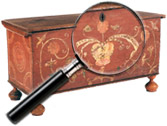|
|
Qi Baishi
Qi Baishi is possibly the greatest of modern Chinese painters and his works are collected worldwide by museums and private collectors. His very personal style developed over the years after beginning studies with master Wang Xiangyi in the late 19th century and continuing with his integration into the artistic circles of Beijing. He began teaching traditional Chinese painting at the Beijing Art Academy in 1927, while expanding his personal style into contemporary [...] Click here to continue reading.
Yingqing Ware
Yingqing, which may be translated as “shadowy blue”, is the modern name given to a utilitarian ceramic introduced into China by the Mongols during the Song dynasty (960 to 1279). Historically called Qingbai (bluish white) ware, it was very thin translucent porcelain made by combining kaolin clay with finely ground porcelain stone. The kaolin provided a true white color for the ware and minimized shrinkage. Although the imperial court was the major [...] Click here to continue reading.
The Japanese Meiji Period (1868-1911)
In 1867/68 the Tokugawa shogunate era came to an end with the restoration of imperial power to the emperor Meiji (died, 1912) and the transfer of the government from Kyoto to Tokyo. The actual political power was transferred from the Tokugawa Bakufu into the hands of a small group of nobles and former samurai.
Like other subjugated Asian nations, the Japanese were forced to sign unequal treaties with Western [...] Click here to continue reading.
Boardman Family of Pewtersmiths
The Boardman family of pewtersmiths provided many of America’s leading practitioners of this craft in the first half of the nineteenth century. Four Boardman brothers, Thomas Danforth (1784 to 1873), Sherman (1787 to 1861), Timothy (1798 to 1825) and Henry S. (1820 to 1895), were born into Connecticut’s first family of pewtersmiths, having descended from the craft’s patriarch, Thomas Danforth of Norwich (1703 to 1786), through their mother Sarah Danforth [...] Click here to continue reading.
Roy Conklin at his workbench – courtesy of http://freepages.genealogy.rootsweb.com/~twigs2000/roystoys.html Roy Conklin, Master Duck Carver
A native of New York’s Alexandria Bay on the St. Lawrence River, Roy Conklin, born in 1909, was a self-described “jack-of-trades”, as a young man coming to maturity during the Great Depression in a small town and rural environment.
Conklin worked as a boat captain on the St. Lawrence, a hunting guide and a carpenter. Having an artistic [...] Click here to continue reading.
Collection of Earl Townsend, Jr.
The singularly most significant collection of North American Prehistoric Art and Artifacts ever assembled.
Earl Townsend, Jr., who died in 2007, was a passionate collector and historian of Native American artifacts. His storied collection of prehistoric stone Indian artifacts remains one of the largest and best collections ever assembled. Hubert C. Wachtel, author of Who’s Who in Indian Relics, called Townsend’s collection “one of the finest in the United [...] Click here to continue reading.
Abraham Bogardus (1822 to 1908)
Abraham Bogardus (1822 to 1908) was trained in the Daguerreotype process by George W. Prosch in New York City. By 1846, Bogardus opened a studio and gallery in New York City on 363 Broadway, and he became very successful in his work. In 1868, he helped found the National Photographic Association, serving as President of the association from 1868-1874. From 1847-1852, Bogardus was listed as a Daguerreotypist at 217 [...] Click here to continue reading.
Stahl Pottery
The Stahl family of potters were the last in Pennsylvania to work in the early tradition of a large round wood-fired kiln and saggers. They produced distinctive wares, often with rope-twist handles, incised decorative motifs, and applied floral and foliate ornament.
The Powder Valley Pottery was founded in 1847 by Charles Ludwig Stahl (1828 to 1896) in Powder Valley, Lehigh County, Pennsylvania. Following Charles’s death the pottery was continued by his sons [...] Click here to continue reading.
Collection of Ervin F. Cheney (1844 to 1922)
It is often said that men like Ervin F. Cheney invented the old west, but it seems just as likely that the old west invented him. In fact, his life reads like a script for a Hollywood movie, beginning in the carnage of the Civil War and running through all the phases of life for a pioneer in territorial Wyoming, from Indian wars through gold fever, [...] Click here to continue reading.
Hematite Artifacts
Hematite is the mineral form of iron oxide comprising up to 70 percent iron. It is colored black to gray, brown or red, usually with a rust-red streak. The mineral takes its name from the Greek, “haimatites”, which we translate as bloodlike, thus the name alludes to the vivid red color of the iron powder.
Hematite is harder than pure iron, but much more brittle. Large deposits of hematite are found in [...] Click here to continue reading.
|
Recent Articles
- Charles Alfred Meurer – American Artist & Tromp L’Oeil Artist
- Sendak, Maurice – American Artist & Writer
- Godie, Lee – American Artist
- Davis, Vestie – American Artist
- Bartlett, Morton – American Artist
- Mackintosh, Dwight – American Artist
- Evans, Minnie Jones – African-American Artist
- Mumma, Ed (Mr. Eddy) – American Artist
- Nice, Don – American Artist
- Savitsky, John (Jack) – American Artist
- Gordon, Harold Theodore (Ted) – American Artist
- Dial, Thornton – African-American Artist
- Doyle Sam – American Artist
- Johnson, Lester Frederick – American Artist
- Finster, Howard – American Artist
|
|
